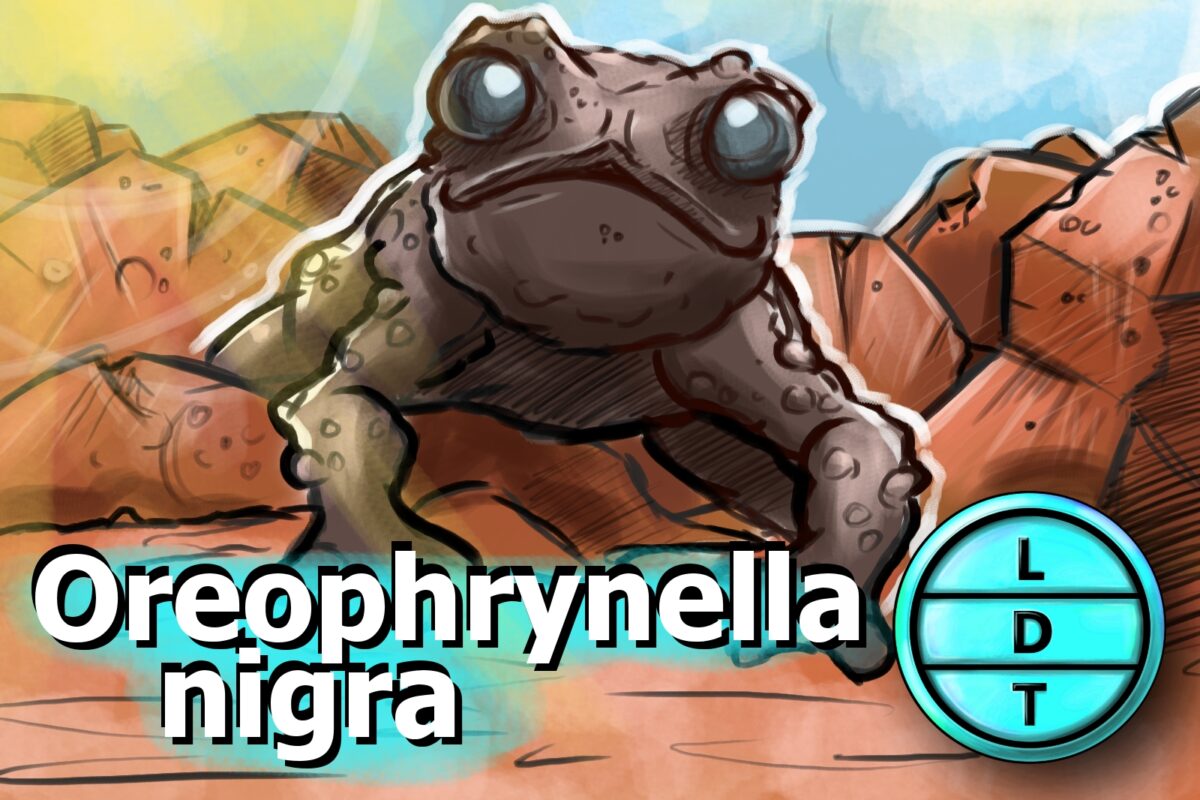“…And today we’re talking about a frog that rolls with the punches. But more on that later.”
High in the table-top mountains of Venezuela, a tiny pebble toad inches its way across the moist sandstone outcroppings. Little does he know that danger lurks just around the corner. A toad-eating tarantula is on the hunt and it’s out for blood. With the advantage of size, speed, and ferocity, the spider seems like a shoo-in for the victory, but the pebble toad has a plan for exactly this kind of situation. Rather than go toe to tarsus with the terrible tarantula, it opts to just roll away from its problems. But sometimes you just gotta let go of the ledge you thought was so secure in order to survive here in Life, Death, and Taxonomy.
Taxonomy
Bufonidae are true toads and belong to the same family as the Colorado River Toad.
Other alumni like the emei mustache toad and the surinam toad are not true toads.
There are nine species of Oreophrynella.
Description of the Pebble Toad
- The pebble toad is a small black frog with a pill-shaped body and spindly legs.
- Their legs are proportionally shorter than other frogs and they sit with their bellies close to the ground, instead of upright like other frogs.
- Their backs are covered in tubercles, which are little bumps.
Measure Up
Welcome to the beloved Measure Up segment. The official listener’s favorite part of the show! The part of the show when we present the animal’s size and dimension in relatable terms through a quiz that’s fun for the whole family. It’s also the part of the show that’s introduced by you when you send in audio of yourself saying, singing, or chittering the words Measure Up into ldtaxonomy at gmail dot com. We don’t have a new Measure Up intro!
- Mountain goat
- Two-toed sloth
- Panda
- Aye-aye
Length from snout to vent
- 16.5–23.5 mm (0.65–0.93 in)
- How many pebble toads go into the largest species of centipede in the world?
- Hint: The giant centipede is found in Central and South America. Some particularly large specimens were found in a cave in Venezuela where they hung from caves to feed on bats.
- 11 toads. The giant centipede is 26-cm-long (10-in).
Living elevation
- 2,300–2,700 m (7,500–8,900 ft)
- How many of the largest balls of human hair would it take to get to the top of the pebble toad’s range?
- Hint: The hairball was collected by barber Henry Coffer and it reached record heights in December of 2008 in Charleston, Missouri. He collected hair for the ball for 50 years. Coffer sadly passed away in 2017, but his keratin collection lives on and is now owned by Ripley’s Believe it or Not!
- 2,225 hairballs. The ball was 4 ft high and weighed 167 lbs (75.7 kg).
Fast Facts about the Pebble Toad
- The pebble toad lives in the highlands of Venezuela on the Guiana Shield, which is a territory.
- They enjoy rocky areas and peat bogs, where they eat small insects.
- All of the species in their genus live on montane tepui, which are highland messas, or tabletop mountains. Some species in the genus are only found on a single tepui.
- Because they have such a restricted range, they are listed as vulnerable, and habitat loss is a major threat.
- Members of the genus have opposable digits on their feet.
- They also experience direct development, which means there is no tadpole stage and they hatch as little toads.
Major Fact: Rock n’ Roll
- We all have some sort of response to danger whether it’s running, hiding, freezing, or fighting. Some even mimic other animals.
- But the pebble toad has a different strategy: toss itself off a cliff
- Pebble toads live almost exclusively on large mesa-like mountains that are completely flat on top (called “table-top mountains)
- Often, the tops of these tepuis create very unique ecosystems and food chains.
- For example, there are no snakes on top of these mountains, even though there are snakes in the jungles below.
- So the pebble toad has one fewer predator to worry about
- However, it is still hunted by the tarantula, so it needs an escape route
- It can’t jump very far or move very fast – it’s not poisonous, tough, or strong. So how can it get away?
- The answer is to play ball
- The pebble toad tenses its muscles and brings its limbs close to its body in a ball position
- Since it spends a lot of time sunning on the sides of rocks, it will usually just roll off the edge and bounce down – like a pebble.
- Gravity is often a faster means of motion than hopping and can usually outrun the tarantulas. At the bottom, the toad usually comes to rest in a crevice or other hard-to-reach place.
- Its coloration also helps it blend in with the real pebbles around.
- Because the toad is so lightweight, the impact of each bounce is minimized, allowing it to get to the bottom of the rock it’s on without much injury
- However, it can’t swim very well so landing in anything larger than a puddle could be fatal
- There is a clip of this happening on Life with David Attenborough so check it out when you get the chance.
Ending: So keep an eye out for spiders, always have an exit strategy, and just roll with what life throws at you like the pebble toad here in Life, Death, and Taxonomy.

